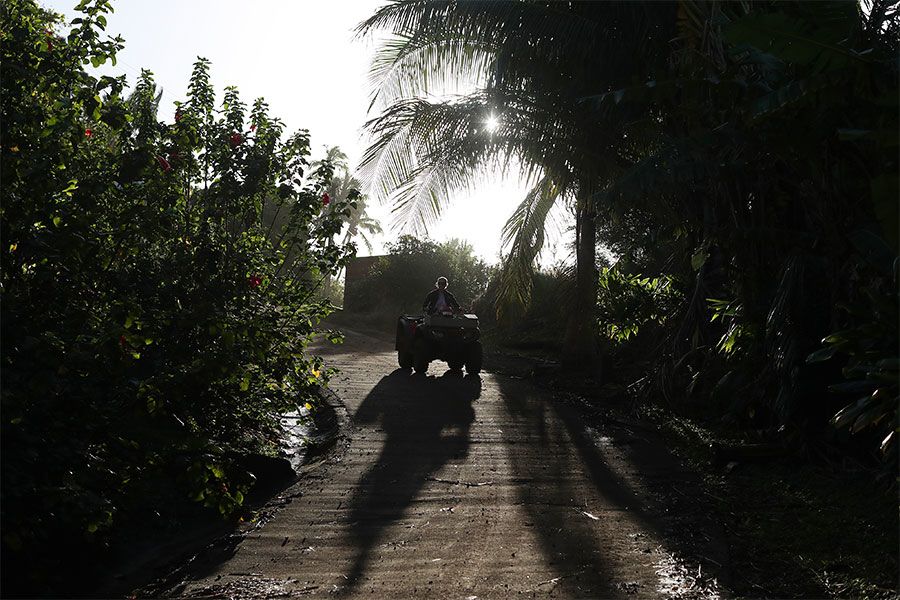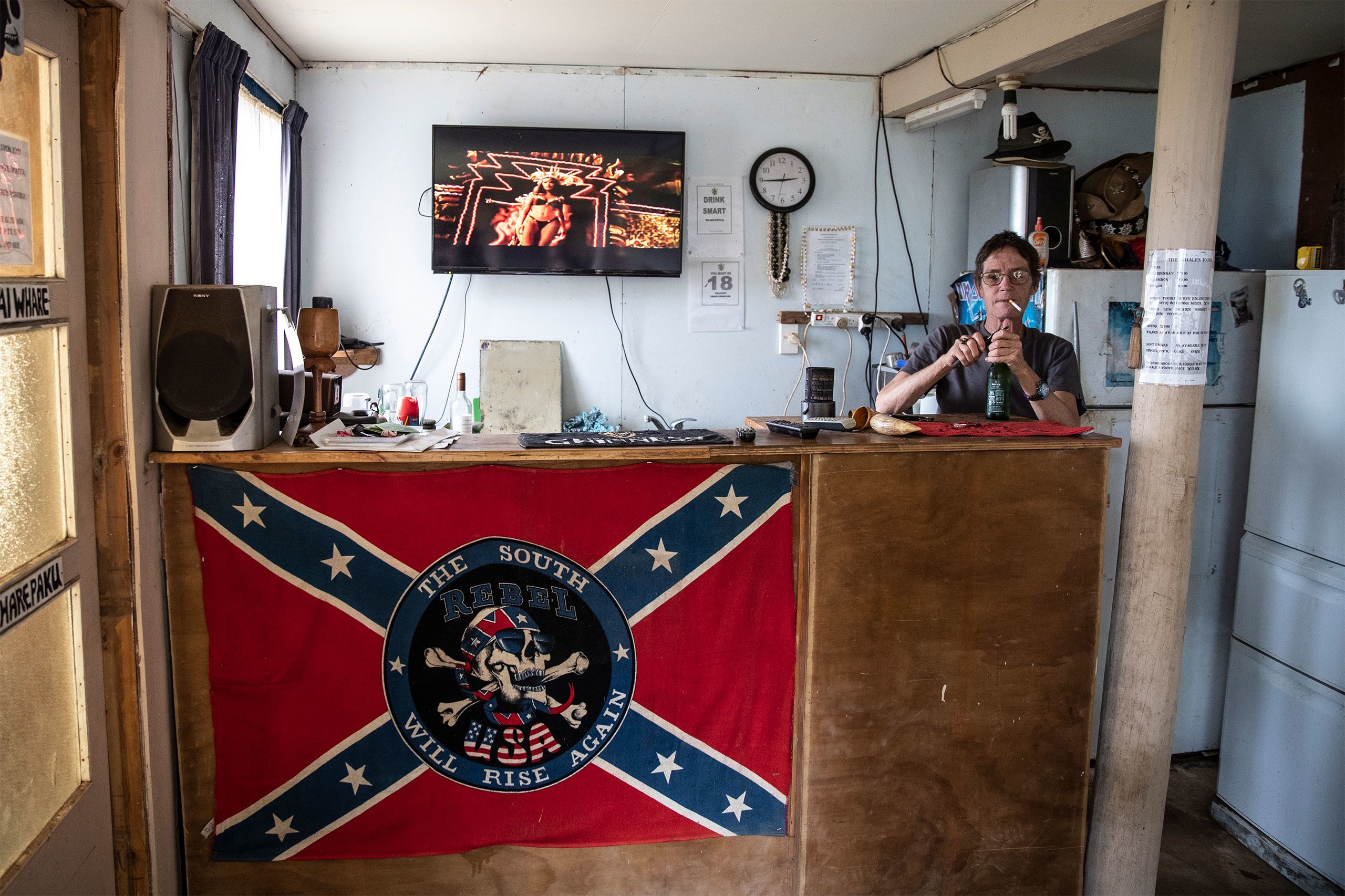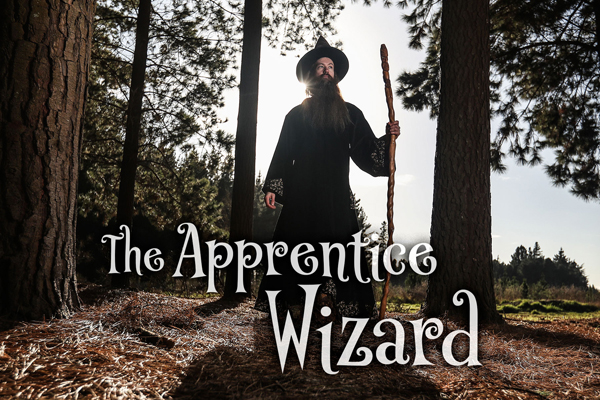
Pitcairn’s Tahitian foremothers called it Hitiaurevareva, the island far away.
Living in one of the world’s most inaccessible places can be challenging.
But Pitkerners relish what they have - rather than what they miss.
Journalists Andrea Vance and Iain McGregor went to meet with the islanders whose blood flows down through two centuries from the Bounty mutineers.
Lost in the blue of the Pacific, Pitcairn Island is one of the loneliest places on earth.
Visitors, imports and exports are carried in on the powerful ocean swells that pound the volcanic outcrop.
The island is more than 500km - a 32-hour ocean crossing - from the nearest airstrip.

Totegegie Airport serves the Gambier Islands, more than 1600km from Tahiti.
Totegegie Airport serves the Gambier Islands, more than 1600km from Tahiti.
Travellers must fly from Papaeete to the 3500-ft long runway on Mou Totegegie, a coral reef in the Gambier Islands, the most remote archipelago of French Polynesia.
The 1700km flight only runs on Tuesdays, and takes almost five hours, with a stop-off on Hao, the former military base from which France ran their nuclear testing. Luggage is strictly weighed.
The plane lands at 1.20pm and shortly after, a local barge makes the 9km trip across the wind-swept lagoon, motoring around flying fish and black pearl farms.

The MV Silver Supporter is Pitcairn’s chartered freighter.
The MV Silver Supporter is Pitcairn’s chartered freighter.
From there, the Silver Supporter, an orange-hulled cargo ship leased by the British Government, makes the voyage to Pitcairn. It leaves French waters and sails into a Britain’s only overseas territory in the Pacific.
Wellington is 5333km away, and Santiago, Chile, 5776km. Ships used to pass more frequently, on lanes that ran between New Zealand and the Panama Canal. The island’s steep contours make landing an aircraft impossible.
Fewer people now visit Pitcairn than climb Mt Everest in a year.
Even getting onto the 5 sq km island is an adventure.
Its towering black granite cliffs, and rocky coastline are continually pounded by waves.
Visiting ships must moor one nautical mile out to sea and wait for the islanders to arrive in one of their aluminium-hulled long boats.

‘Cargo day’ can see all kinds of essential goods brought onto the island.
‘Cargo day’ can see all kinds of essential goods brought onto the island.
First, the cargo is unloaded. Oil drums, containers, even vehicles are manoeuvred into the deep belly of the boat, with practised skill.
There is constant movement, both vessels pitch and roll on the churning sapphire ocean. A crane swings back and forth slowly, and the islanders keep constant tension on the ropes.
They are barefoot, laughing and utterly confident.
At the front, with a crop of blonde-silver shaggy hair, is New Zealander, Darcy Harding.
On the tiller is coxswain Jay Warren, 63, a sixth generation descendant of the Bounty mutineers.
He’s flanked by two of his grandsons Jayden, 21 and Kimiora Warren-Peu, 18. They banter back and forth in Pitkern, a lullaby mix of old English and Tahitian.
Mayor Shawn Christian, 44, oversees the unloading, shimmying up and down the side of the ship and shouting instructions.
When it’s time to alight passengers, he coaxes them down a swinging Jacob’s rope ladder. As the swell reaches its peak, he catches their fall and dumps them on the floor of the longboat.

Shawn Christian clambers aboard the freighter as Jay Warren and grandson Jayden Warren-Peu look on.
Shawn Christian clambers aboard the freighter as Jay Warren and grandson Jayden Warren-Peu look on.
There is no safe harbour on Pitcairn. Instead the crew hold for just the right breaker, and ride it in through a narrow channel that ends behind a breakwater.
It’s wet, and thrilling, and terrifying in equal measure.
On cargo day, almost everyone rides their quad bikes and tractors down to The Landing.

The Hill of Difficulty twists up a steep cliff to Adamstown.
The Hill of Difficulty twists up a steep cliff to Adamstown.
From the harbour, the Hill of Difficulty rises steeply 70 metres to Adamstown, the only settlement. It’s paved, but soon gives way to unsealed tracks, sticky with the island’s inescapable red clay mud.
It takes most of the island to restock the general store, run by Olive Christian, with tractors running back and forth most of the day.
When the latest supply run arrived in June, there were just four loaves of bread left in the shop’s freezers.
The shop opens three mornings a week, for an hour. It’s stocked with everything you could want - from tinned and frozen goods, spices, to cake mix and Lindauer bubbles. There’s even a chocolate fridge.
A European Union development grant is building the islanders a new shop, on a plot next door.

Olive Christian runs the island’s general store.
Olive Christian runs the island’s general store.
“I like the job. I like the office side of it, and selling, and meeting people. It’s a gathering place, people like to catch up,” Olive Christian said.
Some of them just hang around and have a chat.
Simon Young, 53, editor of the island’s newspaper, the Pitcairn Miscellany, says the shop is a focal point.
“When it’s open everybody is there - there is nobody who you don't see.”
He moved to the island 20 years ago, with wife Shirley, 58. “I like the fact that I know everybody on the island, and interact with them, and there is no-one who surprises me. The way the community comes together in emergencies. All these things I love.”
An alluring combination of isolation, and a tight-knit community, dependent on each other, is what draws settlers to this “Paradise Lost”.
Pitcairn is a society that has largely been left alone since it was founded in 1790 by nine British mutineers and 18 Tahitians.

The Adamstown hamlet is the second smallest capital in the world.
The Adamstown hamlet is the second smallest capital in the world.
The island was wrongly charted when it was discovered in 1767, and Captain James Cook struggled to locate it six years later. It took the HMS Bounty crew nine months of sailing across the Pacific to find the island.
They remained undiscovered until 1808, by which time only one mutineer, John Adams, remained alive.
“I have never experienced a sense of isolation here, ever,” Menzies, a descendant who moved to Pitcairn in 2005 said. “It is a very supportive community.
“And when we are out on the longboats, out on the ocean, we put our life in the hands of the people who are in the longboat.
“Everybody trusts that implicitly so you get to experience community at a very intense level. Some people don't have that ever.”
Occasionally, they squabble, but feuds never last long.
“That's normal. Every community has a bust-up every now and again, but you get over with it, say your piece, and carry on,” Brenda Lupton-Christian said.
“Everybody is so close, you are one big family, regardless of whether you might be a Young, Warren or Christian,” she added, referring to the island’s original family names.
The square is the island’s heart. One one side is the Seventh-day Adventist Church, where Saturday services are attended by half the islanders.

Kimiora Warren-Peu has returned to island after studying in New Zealand.
Kimiora Warren-Peu has returned to island after studying in New Zealand.
Next to it are the council office, the Treasury Office and the Post Office. Directly opposite, a walkway leads to the medical centre.
The public hall, stands on the other side of the square, behind the Bounty’s Anchor. It is court house, council chambers, and social meeting place.
“Birthdays are a big deal,” said Menzies.
Old and young will celebrate birthdays and that will often entail a public dinner, where basically the whole country gets together and celebrates.
The islanders also come together for a pot-luck Christmas dinner. They buy their food, and their gifts from Olive Christian.
“You never know, you might even get a can of corned beef,” Christian said.

The British Government tried to eradicate Pitcairn’s wild goats - but some islanders resisted.
The British Government tried to eradicate Pitcairn’s wild goats - but some islanders resisted.
“It doesn't have to be fancy presents, like clothing, things like that. It's amazing what they find to wrap up in and put under the Christmas tree.”
Menzies explained: “You don't hand presents to somebody individually...
“‘Callers’ will call out your name at the top of their voice and it is just this cacophony of laughter and yelling and then you got up and get your present. You don’t necessarily know who it has come from. It's like a secret Santa, but on a grand scale.”
The biggest celebration in the island’s calendar is Bounty Day, to mark the burning of the ship by the mutineers on January 23.
“It’s a fish fry at The Landing,” Lupton-Christian said. “While we are out fishing the ones who don't go will create a model [of the ship] to burn. We finish off the night with fireworks.”
The island is also home to the world’s most remote pizzeria, run by Andy Christian. Open on Fridays, orders have to be phoned in by Thursday night.

Kiwi Sue O’Keefe is a former prison officer who fell for islander ‘Pirate’ Pawl Warren.
Kiwi Sue O’Keefe is a former prison officer who fell for islander ‘Pirate’ Pawl Warren.
There’s also a speakeasy - the Whaletooth Tavern, in the home of ‘Pirate’ Pawl Warren and his Kiwi partner Sue O’Keefe - where visitors are dared to neck potent tequila from a humpback whale’s tooth.

Paul Warren’s Friday night parties are legendary.
Paul Warren’s Friday night parties are legendary.
Over drinks, Warren shows off a collection of Bounty artifacts, and the top of his thumb, now stored in a specimen jar after being amputated in an accident. The mishap doesn’t stop him strumming on an intricately carved mandolin.
However, many of the islanders are strictly religious and don’t drink alcohol. They come together on Saturday mornings, for bible reading and an hour-long service.

The island has weathered dark days. Sex abuse trials in 2004 brought shame to its shores, and a sense of resentment towards the British Government.
But life has moved, and the islanders are now trying to write a new chapter.
“There are much better stories to tell,” Menzies said. “We have been more proactive ourselves about that: we are telling our own stories and that is where the point of power lies.”
The Government is also trying to change the narrative and is investing in tourism, and more infrastructure, like internet connectivity and a more frequent shipping service, to encourage re-population.
But the islanders also cling proudly to their traditions and history.
It’s very important that Pitcairn maintains its Bounty descendant population,
“It’s very important that Pitcairn maintains its Bounty descendant population,” Menzies explains.
“The children here who are eighth and ninth generation, [if] you ask them anything about their heritage and their ancestry they will be able to tell you exactly who they are.
“It is a very interesting thing to see, people so solid in their sense of identity. It is rare.”
Pitcairn Governor Laura Clarke, who is also Britain’s High Commissioner to New Zealand, has twice visited the island.
“It is an extraordinary thing to have an island with that heritage, with that history, with the language. It is really special.
“If it had a UNESCO-type designation for human communities, Pitcairn would get it.
“The Pitkerners have survived against the odds since 1790 - and have been through ups and downs. It really captures peoples’ imagination.
“It is in our interests to really support it, to make a go of it so it can thrive into the future.”
Meralda Warren, is a guardian of the island’s past.

Mavis Warren was born on the island in August 1936.
Mavis Warren was born on the island in August 1936.
At home, with her 83-year-old mother Mavis, she speaks the local dialect, Pitkern, and teaches it to the island’s school children. It blends English, Tahitian and Creole, the original tongues of the mutineers.
“Pitkern is my first language. If we are amongst our own we speak only Pitkern. It is always evolving. The ones who are in the older generation, we speak a much broader Pitkern, than the children where there’s a lot of English influence in the language.”
The Pitkern greeting is Whata way ye? Food is whettle, good food would be “gude whettle.” Numbers are the same as in English.
Another common phrase Warren repeats is: “How shep out yeahna over yonder trying to unload our cargo [the ship is out there trying to unload our cargo].

Meralda Warren tends the grave of mutineer John Adams.
Meralda Warren tends the grave of mutineer John Adams.
“And we don't have a V in our Pitkern language: we say of walley instead of valley.”
Warren, whose family have lived in their ‘Maimiti Haven’ home for 64 years, is also an artist and poet. More than a decade ago, while recovering from back surgery, she revived the tradition of weaving tapa cloth.
She’s also written two recipe books, explaining the island’s cuisine.
“We no longer cook in the stone ovens, and have gone to a more modern way of cooking, which changes the texture and the taste of the food,” she said.
“There’s a traditional dish that only a few of us make now, called a pilhi, using green banana. We refer to the banana as plain. We use a special stone that has been handed down through the generations that is like a grater, called a yolau.
“We also do a taytay pilhi with kumara and one with pumpkin. It’s quite a bland dish, but it complements the fish dishes.”
Pota is another traditional meal, made from mashed palm leaves, coconut cream and a little lime juice.
Crabs and local fish, like nanwei, are abundant and the island’s trees groan with breadfruit, citrus, melons, mangos, papaya. Pretty hibiscus, lantana and frangipani blooms line the dirt tracks, laced between monkey puzzle and twisted banyan trees.
Islanders grow fresh vegetables in the benign climate and fertile volcanic soil, but supplement their diet with frozen produce, shipped from Countdown supermarkets.

Rain is the island’s main water supply.
Rain is the island’s main water supply.
Soft rainwater is the main supply, gathered in huge tanks or bladders.
Traditional homes still heat their water in a ‘copper’ - a drum with a fire fuelled with roseapple wood - but that practice is dying out with modern appliances.
Islanders hoard everything useful and recycle 85 per cent of their rubbish. The rest is burned.
“We have changed in our lifestyle, Warren said. “We have embraced outside influence.
But some of us are quite staunch in keeping some of our traditions going.
The island has a patchy WiFi connection, and many locals have Facebook profiles.
Menzies has the island’s only Netflix account. A cellphone tower has just been erected and most islanders have smartphones.
Warren rejects the idea that technology is changing the island too quickly.
“We have been in touch with the world since way, way back. Ever since Pitcairn was rediscovered, the ships started coming, and then in the 1920s with amateur radio.”
The island might be connected through technology, but physical distance is still a major problem for a population that is getting older and frailer. There is a resident doctor, and a well equipped medical centre, but with no airstrip, evacuation is by sea only.
In dire emergencies, islanders have made the perilous sea journey in their open-deck long boats to Mangareva.
“Don't get sick is the first rule,” Simon Young said. “Be very careful, extra cautious and don't have an accident. You are talking days, rather than moments, to get to a hospital and that’s not good.
You even have to go off for dental work because we don't have a dentist. We are waiting for Star Trek for teleportation.

Most Pitkerners are happy to trade-off modern luxuries and conveniences, for the Arcadian lifestyle.
Brenda Lupton-Christian’s first husband was in the Royal Air Force, so for years she lived in military bases around Europe. She misses only Black Magic chocolate boxes.
“There you are in a confined space, here you are free,” she said of the island where she was born.

Meralda Warren with her ‘copper’ - a traditional way of heating water.
Meralda Warren with her ‘copper’ - a traditional way of heating water.
“You don't have retail therapy, or 24-hour service, but it is a beautiful, free place. It is the freedom of not having to lock things up. Or to go fishing. I live on the ocean, just about, because I love fishing.”
Menzies gets her culture fix when she visits Auckland.
“I've got grown children and grandchildren in New Zealand and my mother is still alive so I have always made a point of being able to get home and see family.
And so then, I do the cafes, and the dinners and the art galleries and everything that I need to do to soak that up.”
But she loves returning. “It is the smell of the island. It is nature and it just has a particular fragrance. As soon as you get on land you are smelling that feeling of being at home.

“Whata way ye?” is how Pitkerners greet each other.
“Whata way ye?” is how Pitkerners greet each other.
“You are part of the weather when you live on an island, in and out of it. You can see where the wind or the rain is coming from… You are very much connected to nature.
“It is so beautifully quiet and when the lights go out at 10pm, all you can hear is the sea. We live right on the top of the island, but we can still hear the sea. We can hear a whale's tail slapping if the wind is blowing in the right direction.
And we have the most beautiful dark skies here. It is really something to come home to.”
Words: Andrea Vance
Visuals: Iain McGregor
Design & layout: Aaron Wood
Editor: Warwick Rasmussen














